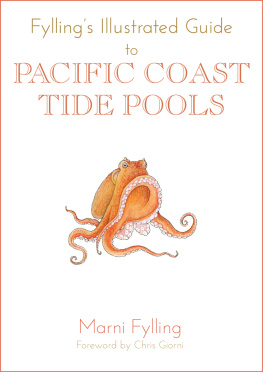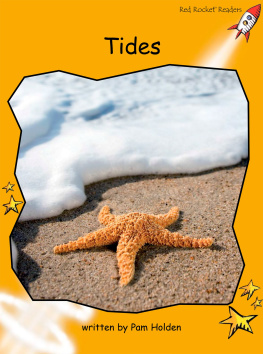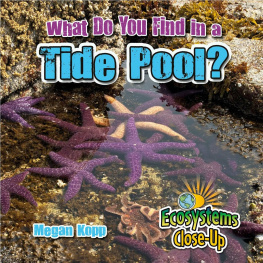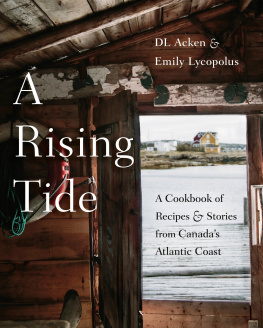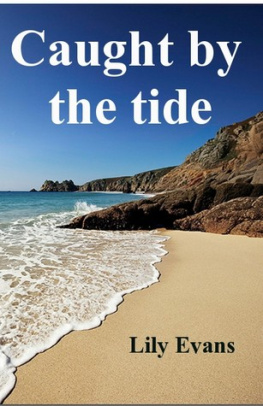Contents
Guide

The publisher wishes to thank the Moore Family Foundation
and Tree Frog Treks for their generous support of this project.

2015 by Marni Fylling
All rights reserved. No portion of this work may be reproduced or transmitted in any form or by any means, electronic or mechanical, including photocopying and recording, or by any information storage or retrieval system, without permission in writing from Heyday.
Library of Congress Cataloging-in-Publication Data
Fylling, Marni.
Fyllings illustrated guide to Pacific coast tide pools / Marni Fylling; foreword by Chris Giorni.
pages cm
Includes bibliographical references.
ISBN 978-1-59714-302-8 (pbk.)
1. Tide pool ecology--Pacific Coast (U.S.) 2. Tide pool animals--Pacific Coast (U.S.) 3. Tide pools--Pacific Coast (U.S.) 4. Marine ecology--Pacific Coast (U.S.) 5. Marine animals--Pacific Coast (U.S.) I. Title. II. Title: Illustrated guide to Pacific coast tide pools.
QH541.5.S35F95 2015
577.690979--dc23
2014041186
Cover Art: Giant Pacific Octopus, Enteroctopus dofleini
Cover Design: Ashley Ingram; Interior Design/Typesetting: Rebecca LeGates
Published by Heyday
P.O. Box 9145, Berkeley, CA 94709
(510) 549-3564
heydaybooks.com
10 9 8 7 6 5 4
CONTENTS
It is advisable to look from the tide pool to the stars
and then back to the tide pool again.
John Steinbeck, The Log from the Sea of Cortes
For Mom, Dad, and Rowan, with love
ACKNOWLEDGMENTS
CHRIS GIORNI IS THE REASON youre holding this book in your hands. We met many years ago at the Bodega Marine Lab, where I saw my first tide pools. Thank you, Chris, for giving me the idea for this guide, along with your unbridled enthusiasm and support. Lucky me.
The cheerful, committed crew at Heyday made this process a pleasurethank you, Lillian, Ashley, Mariko, and Rebecca, and special thanks to Gayle, Jeannine, and Diane.
I have been fortunate to have so many wonderful teachers, a loving family, and special friends who are still helping me discover and navigate the world around me. Mom and Hal, and Dad and Marilyn, got me off to a good start; Mick and Rowan are my fans at home. (Mick broke his scanner, scanning all these illustrations!) Thank you.
And for everybody to whom Ive jokingly offered cookie recipes and marine invertebrate identification in exchange for their brilliant technological/dental/medical/legal assistanceheres that second part. Call me for recipes. Thank you!
FOREWORD
Time to Tide Pool
EVERYTHING FLOWS TO THE SEALETS go, too, you and me, on a blue-green adventure to the beautiful and bizarre world of the tide pools. Look up and around. Its time to re-wild yourself, as the artist Asher Jay says. Its time to scan the horizon for brown pelicans gliding effortlessly over the curving waves, to smell the sweet salt air and spy lined shore crabs scuttling about over the algae-covered rocks.
Check your tide tables, put away your cell phone, and listen to the crash of the waves. Feel the sand beneath your feet and the ocean mist on your face. Feel the calmness that comes with wide-open horizons. Refresh and recharge as you re-nature your life. Watch the rocks getting slapped by the swirling surf, covered in sea-foam one moment and revealing bright orange and purple sea stars the next. A hermit crab races by. A sea anemone dances with the waves. Pink coralline algae paints the rocks, and alien-looking sea slugs swim upside down. Tide pool sculpins flash by, masters of speed and camouflage. All of these creatures have evolved crafty strategies to withstand this harsh environment of battering waves and periodic drought.
Ever wonder what that squishy creature covered with little rocks and pebbles is, over by the edge of the shore? When the tide comes in, it blossoms into a small flower with red-tipped petals. Marni Fyllings illustrated guide will let you know that youve found a group of aggregating sea anemones. Read on and you will learn more about their behavior. Each group has its own unique colony, and they may wage minibattles with the neighboring colonies, reaching over to sting them with half-inch-long tentacles armed with microscopic venomous harpoons.
When I first met Marni, over twenty-seven years ago at a class on Bodega Bay marine invertebrate zoology offered by UC Berkeley, she amazed me with her drawings of ittybitty squid larvae. As you thumb through this field guide, you will see that her drawings explode off the page into life. No matter who you are or what you do, this book is for you. It will enrich your experience and introduce you to the giant green anemone, the purple shore crab, and other small but wondrous creatures. A new friendship awaits when you learn a namefor example, Toni, or Tonicella lineata, the beautifully colored lined chiton that looks like a hand-painted Tuscan ceramic. He waits for you in plain view, fastened to an outcrop. Soon the tide pools will get under your skin and all your salty dawg seafaring friends will be calling you back again and again. These are friendships that will last a lifetime. As Rachel Carson said in her seminal book Silent Spring, Those who contemplate the beauty of the Earth find reserves of strength that will endure as long as life lasts. There is no better way to connect to nature than to go tide pooling.
Once I took a group of city kids tide pooling at Duxbury Reef near Bolinas. Many of them had never been to the ocean before and did not even want to set foot off the bus for fear of getting their new shoes dirty. They all stood by the edge of the trail staring out at the sea. I stepped into a small pool, displayed my dripping shoe, and beckoned. It is okay to get wetcome on, lets go on an adventure! Soon all of them were marveling at black turban snails and hermit crabs. By the end of the day they were completely in the moment, acting like seals on the beach, lying on their bellies, calling out Ark, Bark, Lark! as the tide rolled in and covered them with sand and water. There was much excited chatter on the bus ride home that day.
Who knows? Maybe one day a childs tide pooling experience will inspire a new and efficient way to harness the great energy of the tides and power a new generation of inventors and innovators. Biomimetics strives to mimic natures solutions. For example, mussels secrete a substancebyssal threadsto help secure them to the wet, cold, salty rocks. How do they do it? We dont know! But if we did, scientists speculate, it would be really helpful in repairing bones and tendons. After all, contact lenses were invented by studying the clear scale covering the eyes of snakes and some geckos. Get ready for gecko-inspired sticky-toe-pad tape! Sharkskin is covered in little skin teeth called dermal denticles that channel water and repel algae and barnacles. This has inspired fast swimsuits and a special coating for hospital surfaces to resist bacterial growth. Studying termite dens led to more efficient office buildings, burrs led to velcro, whale fins to super-efficient turbines, and avian migrations to jet plane formations that save fuel.
It may take some planning and even a little coaxing to get out of the house (especially if, like me, you have three kids!) but you will never regret it. Bring an extra pair of shoes and socks just in case. Whenever I go tide pooling I make it a point to walk straight into the water because once youre wet, youre wet: then you can dive right in and let the adventure begin. Lace up your old sneakers, and lets get out and get dirty. Build a fort, climb a tree, hold a bug, smell the sea!

